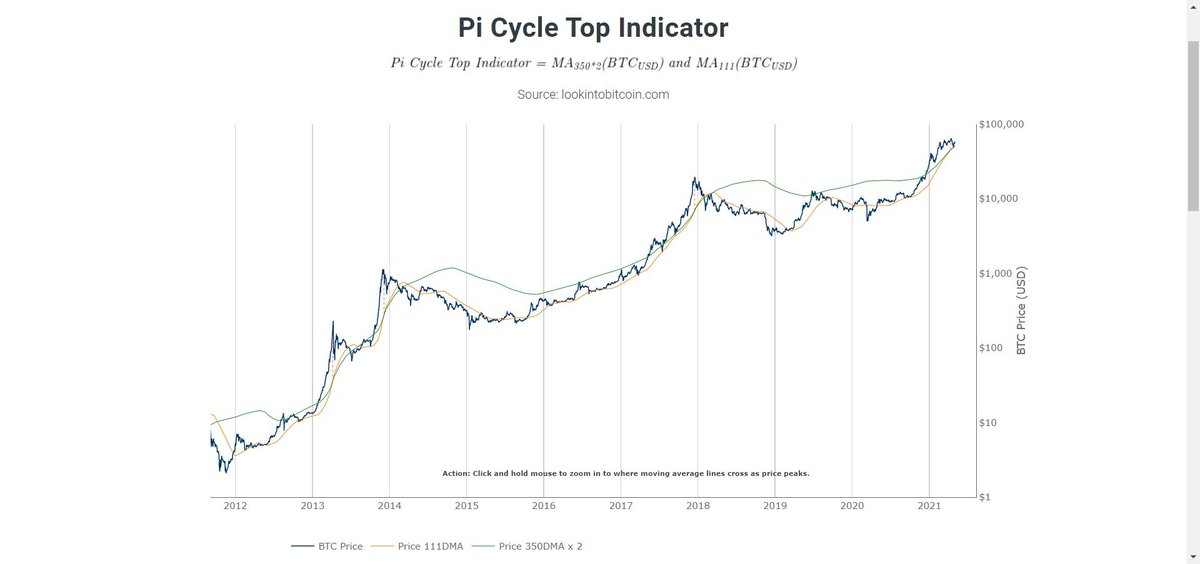$BTC $BTCUSD #BTC
🅼🅴🅶🅰 Thread on several Models / indicators / On Chain Analysis
Part 4
Update at $btc=57k, May 2020
🅼🅴🅶🅰 Thread on several Models / indicators / On Chain Analysis
Part 4
Update at $btc=57k, May 2020
https://twitter.com/Yodaskk/status/1337060555966844932
200 week moving average heatmap now in yellow
advanced in the cycle -similar to q2/q3 2017-but probably not a top yet
advanced in the cycle -similar to q2/q3 2017-but probably not a top yet

Puell multiple
After the higher low, now in a consolidation between 2 & 3 like previous cycles -similar to q2/q3 2017-
After the higher low, now in a consolidation between 2 & 3 like previous cycles -similar to q2/q3 2017-

Pi cycle top indicator gave a pretty good signal at 60k+
This one would be the most bearish signal as of yet
This one would be the most bearish signal as of yet

Bitcoin log growth curves
Similar as previously, seems advanced in the cycle, but doesnt look as a top -probably like q2/q3 2017-
Similar as previously, seems advanced in the cycle, but doesnt look as a top -probably like q2/q3 2017-

MVRV Z-Score made a Parabolic advance starting like previous bull markets
now doing a consolidation between 2 & 6 similar to q2/q3 2017
now doing a consolidation between 2 & 6 similar to q2/q3 2017

Relative Unrealized profit/loss
consolidating in the greed zone -like q2/q3 2017- but didnt touched yet the euphoria area
consolidating in the greed zone -like q2/q3 2017- but didnt touched yet the euphoria area

Miner capitulation, similar to previous cycle
Lol it actually looks so similar, with the halving kicking the hyperspeed
Lol it actually looks so similar, with the halving kicking the hyperspeed

Based from their lows, this cycle seems on track compared to 2 previous ones - and also ~~like q2/q3 2017 

Conclusion:
Some over heating signs start to appear, but overall it seems we are at the equivalent of q2/q3 2017, and that there is still 3-6 months of bull market and at least a last leg up imo
SOURCES:
stats.buybitcoinworldwide.com
charts.woobull.com
lookintobitcoin.com/charts/
Some over heating signs start to appear, but overall it seems we are at the equivalent of q2/q3 2017, and that there is still 3-6 months of bull market and at least a last leg up imo
SOURCES:
stats.buybitcoinworldwide.com
charts.woobull.com
lookintobitcoin.com/charts/
Previous thread
Part 1
$btc= 5k, March 17th 2020, post corona drop
Part 1
$btc= 5k, March 17th 2020, post corona drop
https://twitter.com/Yodaskk/status/1239928982784610305?s=20
Previous Thread
Part 2
Update at $btc=9300, July 2020
Part 2
Update at $btc=9300, July 2020
https://twitter.com/Yodaskk/status/1285562878146338816?s=20
Previous thread
Part 3
Update at $btc=18k, Dec 2020
Part 3
Update at $btc=18k, Dec 2020
https://twitter.com/Yodaskk/status/1337060555966844932?s=20
• • •
Missing some Tweet in this thread? You can try to
force a refresh
































